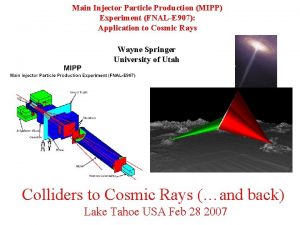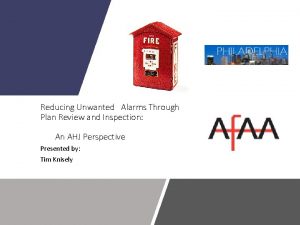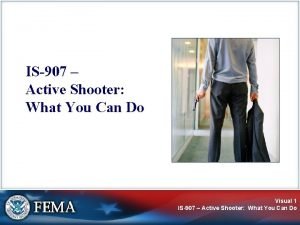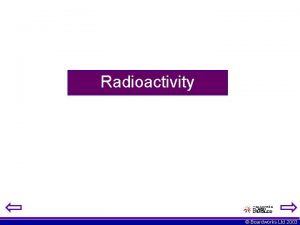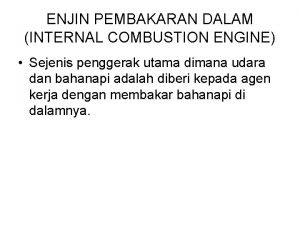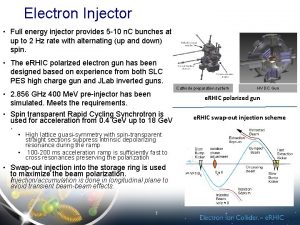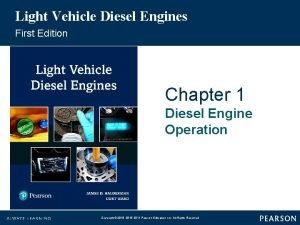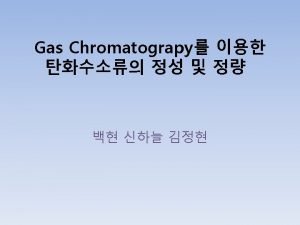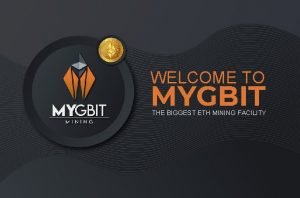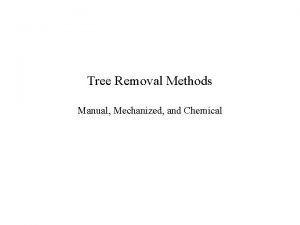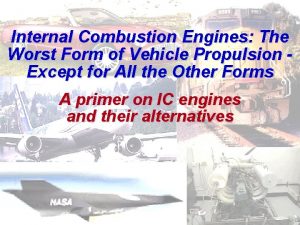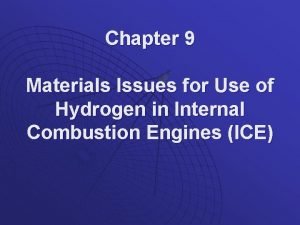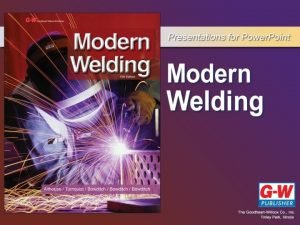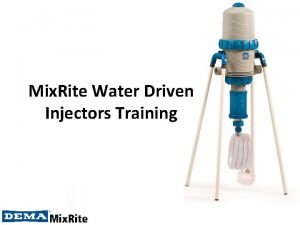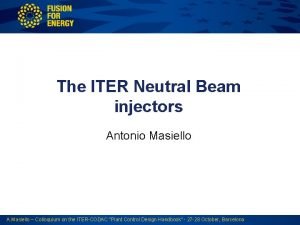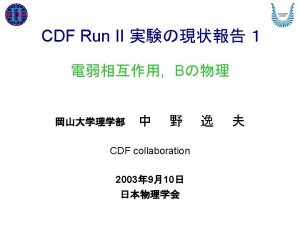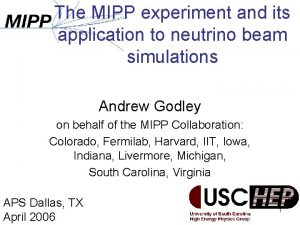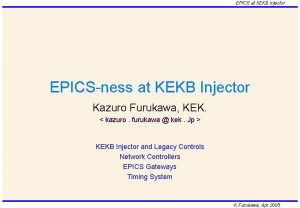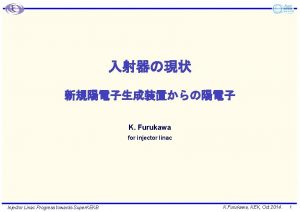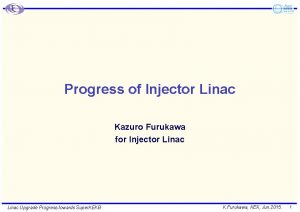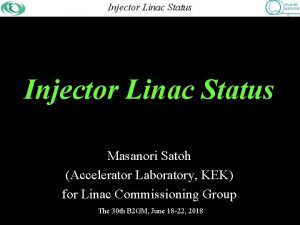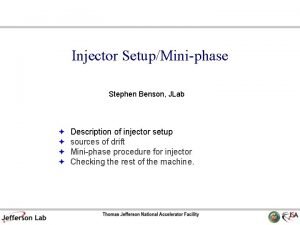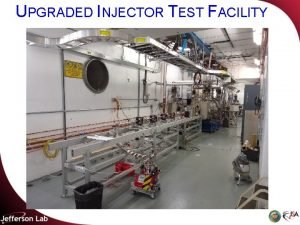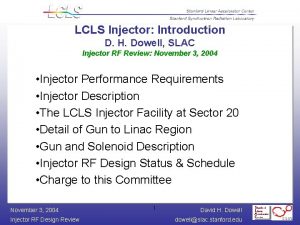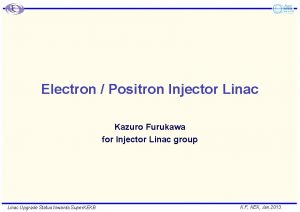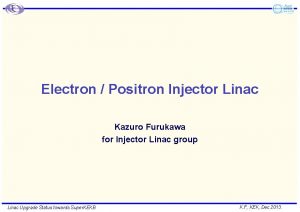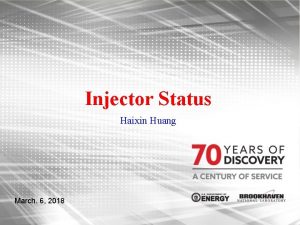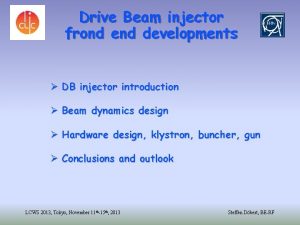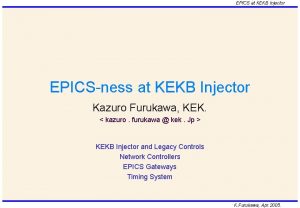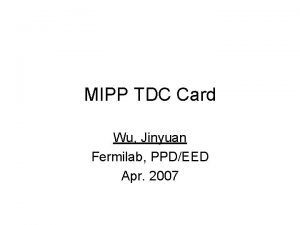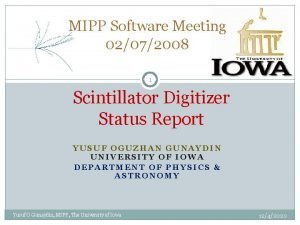Main Injector Particle Production MIPP Experiment FNALE 907
























- Slides: 24

Main Injector Particle Production (MIPP) Experiment (FNAL-E 907): Application to Cosmic Rays Wayne Springer University of Utah Colliders to Cosmic Rays (…and back) Lake Tahoe USA Feb 28 2007

Main Injector Particle Production (MIPP) Experiment (FNAL-E 907): Application to Cosmic Rays • Extensive Air Showers – Determination of UHECR parameters • Energy, Xmax and flux • Measurement Techniques – Modeling of EAS • Hadronic Interaction Models and Corsika • Dependence on particle physics • MIPP Experiment – Description – Measurements applicable to better understanding of EAS

Extensive Air Showers Profiles: Longitudinal and Lateral Profile Ground Arrays Longitudinal Profile Air Fluorescence Only Measure effects related to Charged particle content of Extensive Air Showers !!!!

Determination of UHECR Parameters from EAS Charged Particle Longitudinal Profile ØEnergy and Xmax Determination ØIntegrate Shower profile ØCorrect for portion of shower not observed ØCorrect observed EM energy into total energy Ø Particle multiplicity and cross-section are influences on longitudinal profile shape and fraction correction ØNeed EAS models to calculate detector aperture as well as for energy determination

Ground Array AGASA Lateral Distribution E=2. 13 x 1020 e. V M. Teshima Ø Energy Determination Ø From Local density at 600 m Ø Particle multiplicity, Cross sections and differential cross section influence the relation between S(600) and the Energy of the UHECR Muon/Neutrino Ele. Mag

Externsive Air Shower Modeling Corsika Simulated 1015 e. V proton EAS ØWell developed EAS models exist • High Energy • DPMJET • ne. Xus • QGSJET • SIBYLL • Low/Intermediate Energy • GHEISHA • Hillas’ Splitting Algorithm • FLUKA • Ur. QMD • TARGET • HADRIN/NUCRIN • SOPHIA ØQuestions ØNeutral particles ØEAS Muon Content ØHow close to reality? J. Oehlsclaeger and R. Engel

Hadronic Interaction Models Inputs Particle Data Group R. Engel • Hadronic production • Cross-sections • Multiplicities • Compare to measurements • Extrapolation at high energies

Example of Model Variability Model Predictions: proton-proton at the LHC – Totem Expt- S. Lami Multiplicity Total Energy Predictions in the forward region within the CMS/TOTEM acceptance (T 1 + T 2 + CASTOR)

Main Injector Particle Production Experiment MIPP (FNAL E 907) D. Isenhower, M. Sadler, R. Towell, S. Watson Abilene Christian University R. J. Peterson University of Colorado, Boulder W. Baker, D. Carey, D. Christian, M. Demarteau, D. Jensen, C. Johnstone, H. Meyer, R. Raja, A. Ronzhin, N. Solomey, W. Wester Fermi National Accelerator Laboratory H. Gutbrod, K. Peters, GSI, Darmstadt, Germany G. Feldman, Harvard University Y. Torun, Illinois Institute of Technology M. Messier, J. Paley Indiana University U. Akgun, G. Aydin, F. Duru, E. Gülmez, Y. Gunaydin, Y. Onel, A. Penzo University of Iowa V. Avdeichicov, R. Leitner, J. Manjavidze, V. Nikitin, I. Rufanov, A. Sissakian, T. Topuria Joint Institute for Nuclear Researah, Dubna, Russia D. M. Manley, Kent State University H. Löhner, J. Messchendorp, KVI, Groningen, Netherlands H. R. Gustafson, M. Longo, T. Nigmanov, D. Rajaram University of Michigan S. P. Kruglov, I. V. Lopatin, N. G. Kozlenko, A. A. Kulbardis, D. V. Nowinsky, A. K. Radkov, V. V. Sumachev Petersburg Nuclear Physics Institute, Gatchina, Russia A. Bujak, L. Gutay, Purdue University A. Godley, S. R. Mishra, C. Rosenfeld University of South Carolina C. Dukes, C. Materniak, K. Nelson, A. Norman University of Virginia P. Desiati, F. Halzen, T. Montaruli, University of Wisconsin, Madison Livermore dropped out. Rest still on proposal. 7 new institutions have joined. More inegotiaitions. Previous collaboration built MIPP up from ground level. Less to do this time round. More data.

Main Injector Particle Production Experiment MIPP (FNAL E 907) Ø Beamline Ø Targets Ø Detector Ø Data Ø Physics Topics

MIPP Secondary Beam Line Ø 120 Ge. V Main Injector Primary protons Ø secondary beams of p K p from 5 Ge. V/c to 85 Ge. V/c Ø Measure particle production cross sections on various nuclei including nitrogen.

MIPP Targets Ø Target inserted into TPC Ø Surrounded by Crystal Ball Recoil detector (in upgrade) Ø Cryogenic Target Will allow Liquid N 2 Target Ø Nuclear Targets Ø Ø The A-List Ø H 2, D 2, Li, Be, B, C, N 2, O 2, Mg, Al, Si, P, S, Ar, K, Ca, , Fe, Ni, Cu, Zn, Nb, Ag, Sn, W, Pt, Au, Hg, Pb, Bi, U The B-List Ø Na, Ti, V, Cr, Mn, Mo, I, Cd, Cs, Ba

MIPP Detector ØOpen Geometry Spectrometer Ø“Jolly Green Giant” Magnet ØTime Projection Chamber(TPC) Momentum and d. E/dx meaasurement ØTime-of-Flight (TOF) ØCerenkov Detector ØBeam Cerenkov ØRing Imaging CHerenkov ØTracking Chambers ØExcellent ØCalorimeters ØParticle ID ØElectromagnetic Ø momentum resolution ØHadronic ØMeasure differential production cross-sections for inclusive hadrons Ø“Crystal Ball” (in proposed upgrade)

Time Projection Chamber (TPC) • ØLocated inside the JGG magnet Ø 3 D tracking Ød. E/dx particle identification for particles with low momentum. ØCurrent DAQ rate limited to 30 Hz upgrade to 3000 Hz

Time Projection Chamber Particle ID Number of tracks vs. d. Edx in arbitrary units vs. momentum in Ge. V/c for 20 Ge. V p-C data Number of tracks vs d. Edx in arbitrary units for a momentum slice ranging from 150 Me. V. c to 250 Me. V/c. Data is from a 20 Ge. V p-C run.

Beam Cherenkov Detectors ØTwo differential Beam Cerenkov detectors ØLong radiator (>30 meters total) ØSeparate p/K/p for beam momenta above 10 Ge. V/c ØBeam TOF for beam momenta below 10 Ge. V/c ØProvides beam particle id at the trigger level.

Ring Imaging Cherenkov Detector ØRings are imaged onto an array of 32 x 96 1/2 inch diameter pmts. ØMany hits per ring -> good particle id. Provides Particle ID for particles produced in collision

Overall MIPP Particle ID Performance Good Particle ID over most of p v pt parameter space

The recoil detector Detect recoil protons, neutral and charged pions, kaons

Comparison of model predictions for observable distributions

Transverse Momentum vs Momentum Distributions ØDifferential Cross-Sections for particle production will be measured ØNeed input from model builders as to how to best present the data

Data Taken

Other MIPP Physics Topics Ø Non-perturbative QCD physics Ø Scaling law of particle fragmentation Ø provide new, precise data to theorists so they can test new models Ø Nuclear physics Ø y scaling Ø propagation of flavor through nuclei Ø strangeness production in nuclei Ø Searches Ø Missing baryon resonances predicted by SU(3) Ø Search for glue balls Ø Charged Kaon mass measurement Ø Service measurements Ø neutrino experiments Ø Pion and kaon production on Nu. MI target for MINOS to understand the neutrino flux (energy spectrum) Ø Cross sections on N 2 (air) for atmospheric neutrino experiment flux Ø Proton Radiography (homeland security, etc. )

Summary Ø UHECR measurements are dependent upon particle physics models Ø Measurements from MIPP can provide input to those models Ø Current MIPP data set useful. Work ongoing. Physics DSTs available soon. . Ø MIPP upgrade should be designed with needs of EAS models in mind
 Experiment 907
Experiment 907 Fnale
Fnale Pre dan post production adalah
Pre dan post production adalah Ifc 907
Ifc 907 Is 907 active shooter
Is 907 active shooter Alpha particle production
Alpha particle production Enjin pembakaran dalam
Enjin pembakaran dalam Electron injector
Electron injector Bill nye fuel injector
Bill nye fuel injector Split and split-less injectors
Split and split-less injectors Kioritz soil injector
Kioritz soil injector Mygbit mining
Mygbit mining Hypo hatchet tree injector
Hypo hatchet tree injector Mazzei injector selector
Mazzei injector selector Lbz injector balance rates
Lbz injector balance rates Wankel
Wankel Chapter 42 gasoline injection diagnosis and repair
Chapter 42 gasoline injection diagnosis and repair Injector torch definition
Injector torch definition Cana injector
Cana injector Mix rite
Mix rite Hypo hatchet tree injector
Hypo hatchet tree injector Neutral beam injector
Neutral beam injector Cana injector
Cana injector Oxy blast
Oxy blast Mars injector
Mars injector
